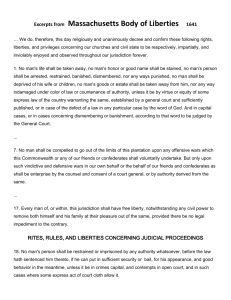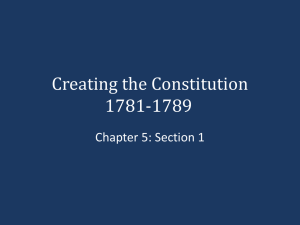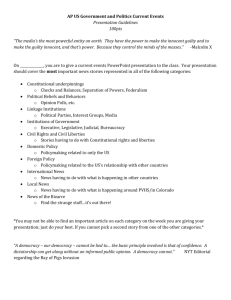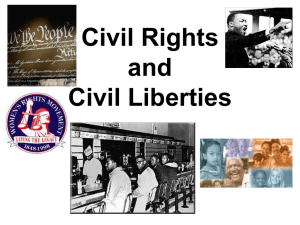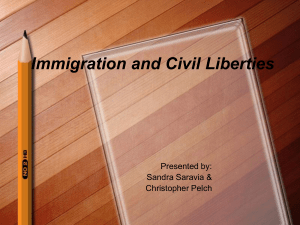EVOLUTION OF THE HUMAN RIGHTS CONCEPT
advertisement
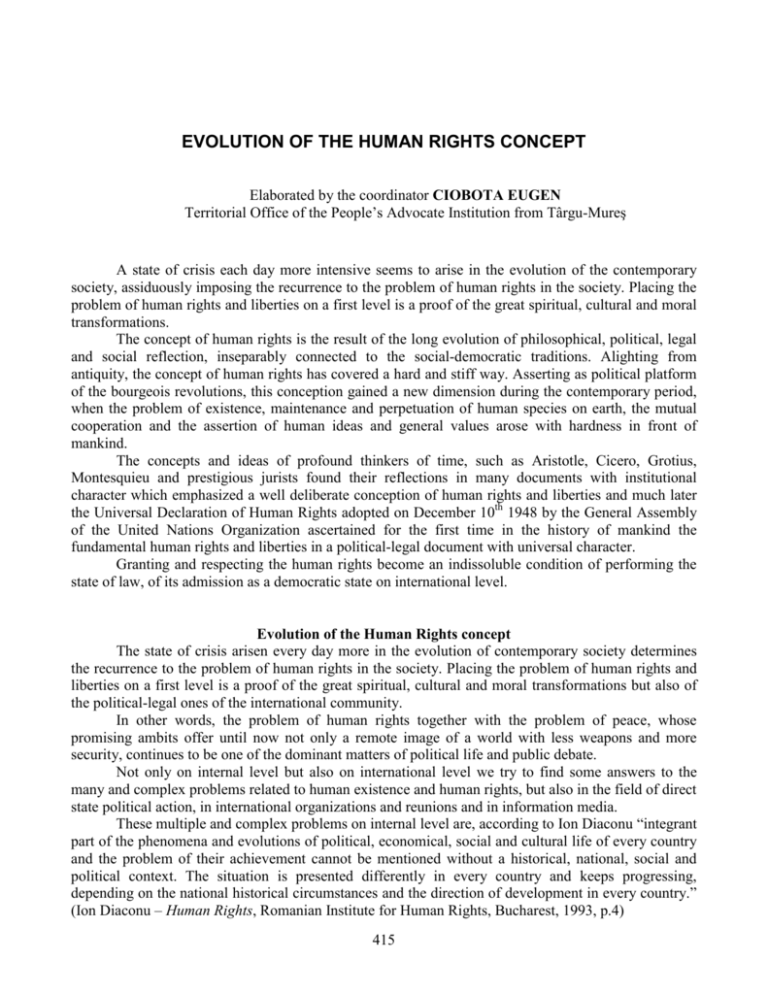
EVOLUTION OF THE HUMAN RIGHTS CONCEPT Elaborated by the coordinator CIOBOTA EUGEN Territorial Office of the People’s Advocate Institution from Târgu-Mureş A state of crisis each day more intensive seems to arise in the evolution of the contemporary society, assiduously imposing the recurrence to the problem of human rights in the society. Placing the problem of human rights and liberties on a first level is a proof of the great spiritual, cultural and moral transformations. The concept of human rights is the result of the long evolution of philosophical, political, legal and social reflection, inseparably connected to the social-democratic traditions. Alighting from antiquity, the concept of human rights has covered a hard and stiff way. Asserting as political platform of the bourgeois revolutions, this conception gained a new dimension during the contemporary period, when the problem of existence, maintenance and perpetuation of human species on earth, the mutual cooperation and the assertion of human ideas and general values arose with hardness in front of mankind. The concepts and ideas of profound thinkers of time, such as Aristotle, Cicero, Grotius, Montesquieu and prestigious jurists found their reflections in many documents with institutional character which emphasized a well deliberate conception of human rights and liberties and much later the Universal Declaration of Human Rights adopted on December 10th 1948 by the General Assembly of the United Nations Organization ascertained for the first time in the history of mankind the fundamental human rights and liberties in a political-legal document with universal character. Granting and respecting the human rights become an indissoluble condition of performing the state of law, of its admission as a democratic state on international level. Evolution of the Human Rights concept The state of crisis arisen every day more in the evolution of contemporary society determines the recurrence to the problem of human rights in the society. Placing the problem of human rights and liberties on a first level is a proof of the great spiritual, cultural and moral transformations but also of the political-legal ones of the international community. In other words, the problem of human rights together with the problem of peace, whose promising ambits offer until now not only a remote image of a world with less weapons and more security, continues to be one of the dominant matters of political life and public debate. Not only on internal level but also on international level we try to find some answers to the many and complex problems related to human existence and human rights, but also in the field of direct state political action, in international organizations and reunions and in information media. These multiple and complex problems on internal level are, according to Ion Diaconu “integrant part of the phenomena and evolutions of political, economical, social and cultural life of every country and the problem of their achievement cannot be mentioned without a historical, national, social and political context. The situation is presented differently in every country and keeps progressing, depending on the national historical circumstances and the direction of development in every country.” (Ion Diaconu – Human Rights, Romanian Institute for Human Rights, Bucharest, 1993, p.4) 415 Ion Diaconu also asserted that “on international level, the matter of human rights is closely connected to the evolution of the global problems of mankind – security, peace, development. The multiple existent problems which appear in every country can only be solved within the context of a positive evolution in fields such as the settlement of the existent problems and the prevention of others, the provision of the development of all countries in the world, the maintenance of peace and international security.” At the same time, we should try to separate the directions of action regarding the collaboration within the states in this field, as resulting from the adopted international commitments and from the manner in which they are practiced within the United Nations institutions and other organizations. Origins and evolution of the Human Rights concepts As social phenomenon, human rights have their origin in antiquity. In exchange, as legal phenomenon, human rights have been originated by the natural law doctrine, starting from the idea that humans, by their own nature, anywhere and anytime have rights that are previous and primary to the ones assigned by the society and admitted by the natural law. In other words, this is a superior right in relation to the expression of state’s will in various forms of its existence and unconditioned by the interests that the state might have in a moment of its historical evolution. In this sense we consider that we may take into account the appreciation made by Giorgio del Vecchio, who asserted that: “The idea according to which the human being by its nature has certain reasons, valid even if they do not correspond or they correspond partly to the dispositions of positive laws, has appeared in human mind since very old times and has been defined in bright words, due to the antic philosophy or to the Roman case laws in the same way as during the following epochs, sometimes inspiring itself from the doctrines of Christian religion, and other times only from the reason light.” (Giorgio del Vecchio – Natural Rights in Europe, p. 195) In antic Greece, Platon (427-447 B.C.) had an important contribution to the development of the conception of necessity of a universal and eternal set of rules regarding human beings. He made a clear distinction between ideas and culture or tradition. His works have a pronounced character of assertion, discovery of human rights and liberties. Aristotle was the first one in asserting the idea of natural law, in his work “Politics” saying: “a person becomes slave or free only by law, human beings do not differ at all by the nature of mankind.” Analyzing the historical development of human society, the Christian philosophers of Middle Ages tried to develop ideas about the condition of humans equality starting from the Decalogue with the 10 commands, announcing in this way the fundamental individual rights characteristic for any human being. According to the theory of Toma d’Aquino, the individual, in this context is in the center of a right social and legal order but the divine law has supereminence over the worldly law, such as it is defined by the king, “The Christian Church even established a hierarchy of various law sources in matter, giving priority to the divine law, on second places appearing the natural law and only on third place the positive law as law derived from the primary (divine) and the secondary (natural), being nothing else than common rules of the relationships in society.” (Ionel Closca, Ion Suceava – Treaty of Human Rights, Printing House Europa Nova, Bucharest, 1995, p. 18) During the 17th century, the exponents of the school of natural law, especially Hugo Grotius, surnamed the father of natural law science, showed that “man is a sociable being by its nature, who wishes to live peacefully with its fellows, able to determine by himself on what is useful or harmful for society.” (Corneliu Barsan – The European Convention of Human Rights, volume I – Rights and Liberties, Publishing House AllBeck, Bucharest, 2005, p.20) These problems were also approached by many thinkers in the 18th century, a significant contribution having J.J. Rouseau and Ch.L. de Montesquieu. Even from the very beginning of its work: About the spirit of laws, Montesquieu formulates a definition of law in a scientist manner meaning: “Laws, in the most ample sense, are necessary reports 416 derived from the nature of things and in this sense, all the works have their own laws. “ (Ch. L. de Montesquieu – De l’esprit de lex, Publishing House Ştiinţifică, Bucharest, 2005, p.20). The quality of Montesquieu is that of having understood in context the relationship between laws and liberty but also the contribution to the ideological preparation of the French Revolution from 1789. This philosophy has a progressive character because, alluding to the essential components of the society, it asserted that “people gave up their natural independence in order to submit to civil laws” mentioning, in conclusion that the first laws represent liberty and the last ones property. Essential to his legal philosophy there is the idea of instituting the reign of law and by itself the reign of people who at the same time is its author and obedient, since the same will creating laws is submitted to them. The equality of people consists in the fact that they are similar in dignity, because, the law belonging to all of them is not owned by someone else in particular. Therefore, law must be placed above people and not one man above the others, since equality involves freedom, taking into account that the compliance to a law determined by someone means freedom.” (J.J. Rouseau – The Social Contract, p. 108) Definitely and unquestionably, the problem of fundamental human rights and liberties is still a constant preoccupation of the great philosophers in the following decades. However, we consider that beginning with the end of the 18th century, the problem of human rights passes to a new phase of development – devotion of rights, even later, in international documents and became what we all admit today – the contemporary system of international law of human fundamental rights and liberties. Appearance and evolution of the first legal instruments for human rights protection Rights and liberties, from the perspective of positive law, later forming the content of the notion of human rights appeared in the battle of various social categories against feudal absolutism. The first text known in history is Magna Carta Libertatum proclaimed in England by king John of England in 1215, thus the English barons and bishops obtaining a lot of advantages and procedural warranties from the king. This document of the epoch had an absolute priority over all the other documents elaborated in time in this field so important for the people form the earth. This document was telling that “No free man could be arrested, imprisoned or dispossessed of his goods, declared against the law, exiled or injured in any matter and we will not be against him or send anyone against him without a loyal judgment of his equals or in conformity with the law of the country.” (Corneliu Barsan – European Convention of Human Rights, p.21). The first legal instruments of transposition in legal provisions of this fundamental rights and liberties appeared in the European culture of the 17th-19th centuries. In England there came out some important documents regarding human rights entitled: The Petition of Rights on the 13th of February 1628, Habeas Corpus Act on the 26th of May 1679, Bill of Rights on February 13th, 1689, “by which the parliamentary system of Great Britain, the right to free elections, the freedom of word, the right of release on bail, the prohibition of cruel punishments, the right to be judged by an independent court” were founded. (I. Demeter – Declaration of Human Rights, Historical Draft, page 27). In the United States of America, state of Virginia, on 12th of June 1776 it was adopted the Declaration of Rights from the state of Virginia, which provided that “all people are born equal, free and independent; they have inherent rights they cannot be deprived of or dispossessed of by any contract, when having social relations, meaning the right to enjoy life and freedom, with the possibility of purchasing and possessing goods and the right to search and obtain happiness and personal security.” On 14th of June 1776 in Philadelphia is adopted the Declaration of Independence of the United States of America, which settles the basic idea that all governances have been established by people in order to guarantee the appointed rights. On December 10th 1948, a date worldwide celebrated as the International Day of Human Rights, it was adopted the Universal Declaration of Human Rights. This text settles a series of fundamental rights – a common ideal that must be accomplished according to the Declaration - for all 417 people, no matter their race, sex, language, religion, political opinion, national or social origin, goods, birth or material situation. This document has been adopted without any hostility from the member states of the United Nations Organization, excepting eight forbearances (South Africa, Saudi Arabia, USSR and five popular democracies). Since the declaration does not have the necessary legal power, not being an international treaty does not determine de jure obligations for the states. Actually, its provisions have been included in the constitutions and internal laws of states and therefore it gained special importance. As a consequence of the fact that the states considered it was necessary to adopt a new document to contain provisions of legal power, during the years 1948-1966 there were negotiations related to the enactment of a document in this sense, culminating with the International Charter of Human Rights, which inspired directly the elaboration and subsequent completion of a range of complementary instruments regarding the regulation of human rights in certain special and concrete fields: • the self-determination and the right to independence for the colonized states • the battle against discrimination for reasons of race, sex, place of work, profession, religion, faith, education • the battle against war crimes and humanity crimes • the protection of persons submitted to a regime of detention or jail • the forbiddance of torture and other analogical inhuman treatments • the rights of handicapped and mental disabled people • the progress and development in the social field • the use of progress recorded by science and technique for the convenience of peace and benefit of mankind • the cultural cooperation and development on international scale • the political rights of women • the battle against racism, war instigation and apartheid • the battle against terrorism • the promotion of human rights For the purpose of minimizing human rights on national and international level, considerable efforts are being made by the release of efficient instruments for reasons of respecting fundamental rights and liberties; the observance of human rights by the states is being monitored. With all problems and voids existent in the literature of specialty it was considered that “the development of human rights in the international law and national legislation has been paved with the elaboration of a system of laws which globally regulate the harmonious existence of personality.” (Gh. Costachi, P. Zaharia – Development of the concept about human rights in the modern and contemporary epoch, p. 19) On European level, in the ambit of legal instruments of protection and warranty in the field of human rights we encounter the community institution – The European Court of Human Rights. By the European Convention for the protection of Fundamental Human Rights and Liberties there was created a mechanism of international control which is added to the national mechanisms, all member states accepting the competence of the European Court of Human Rights as community institution. This authority of human rights defense on international and regional level has the role of an instance of international jurisdiction with a character subsidiary to the internal modalities of attack. The European Court is not a statutory organism of the European Council but a conventional one elaborated on basis of the European Convention of Human Rights. However, it cannot be separated by the system of the European Council authorities, being created within this, taking the same principles and even having the same budget. The European Council of Human Rights, with the headquarters in Strasbourg from January 21st 1959, together with the acceptance of its jurisdiction by eight states, is the main element of the supranational mechanism of control of the application of the European 418 Convention for the defense of Human Rights and Fundamental Liberties, denominated the European Court of Human Rights or referred to by the CEDO symbol. 419

